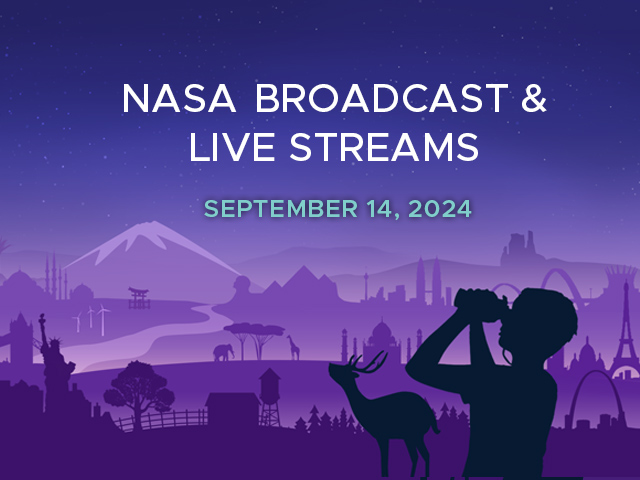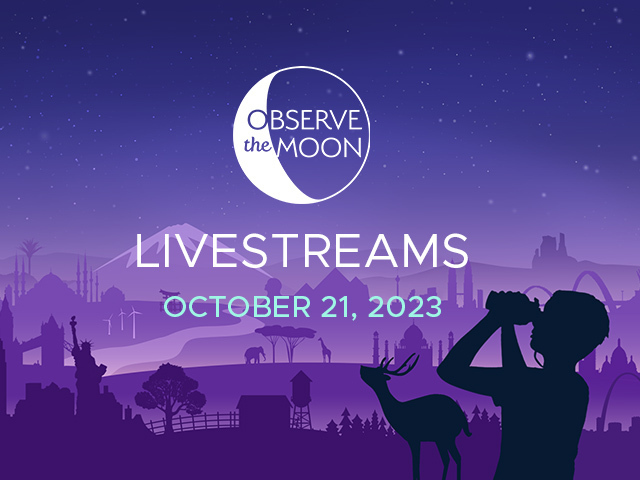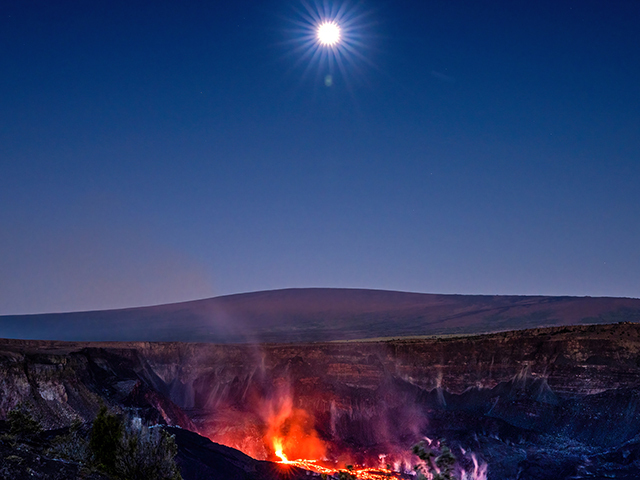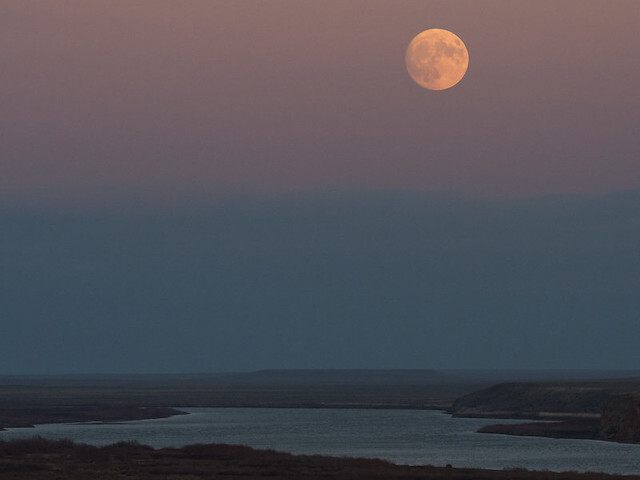News | November 10, 2016
The Next Full Moon is the Beaver Moon and a SuperMoon
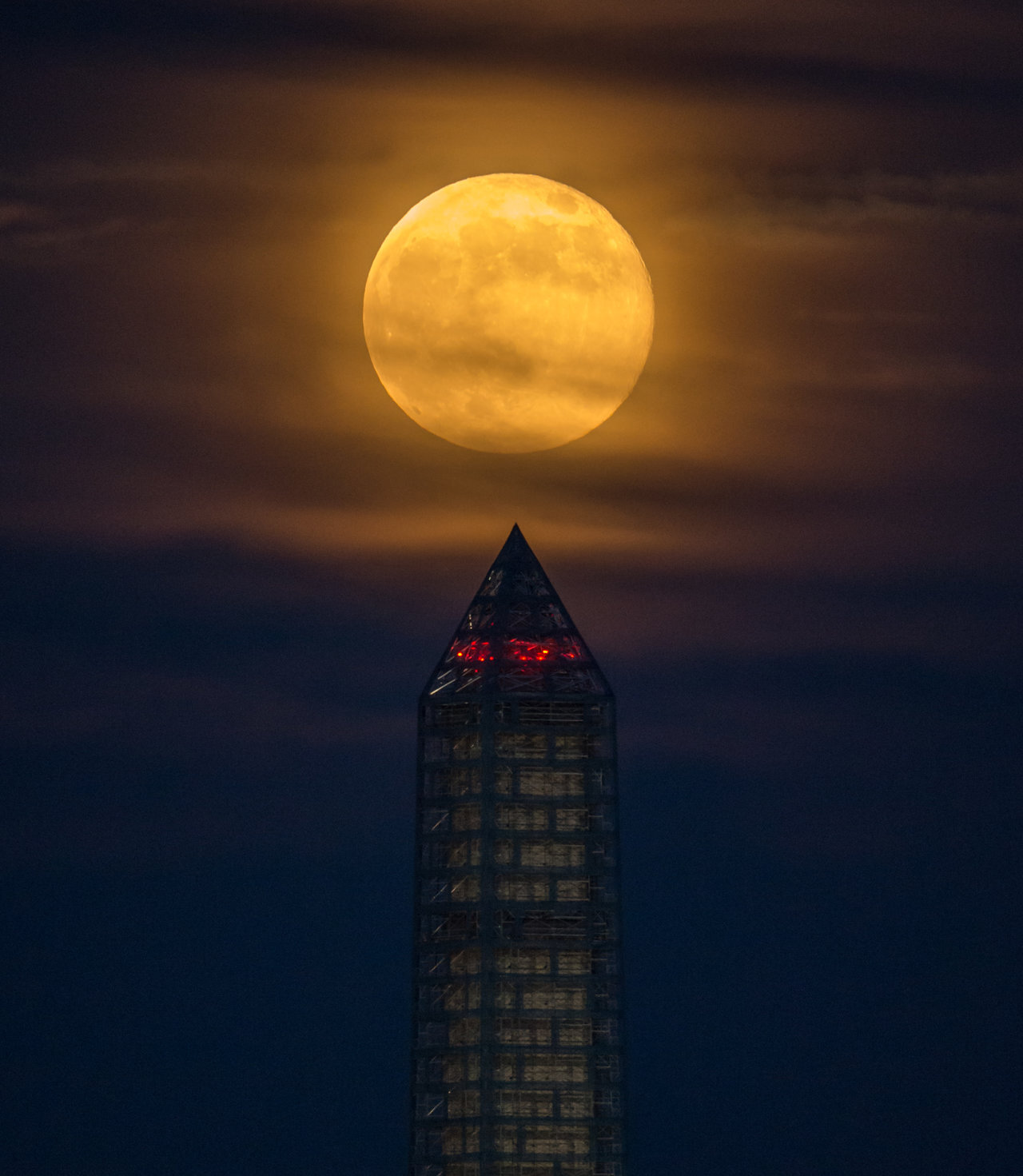
A supermoon rises behind the Washington Monument, Sunday, June 23, 2013, in Washington.
The next full Moon will be on Monday morning, November 14, 2016, appearing "opposite" the Sun (in Earth-based longitude) at 8:52 AM EST. The Moon will appear full for about three days around this time, from Saturday evening through Tuesday morning (possibly even into Tuesday evening).
This full Moon is a "SuperMoon." The term SuperMoon was introduced by a modern astrologist in 1979, has become popular in the last few years through Internet sharing, and now generally means a full Moon that occurs on the same day as when the Moon is closest to the Earth in its orbit, called perigee. At perigee, the Moon can be as much as 14% closer to the Earth than at apogee. Something 14% closer to you appears 14% larger across and 30% larger in area, so a full Moon at perigee will reflect 30% more sunlight onto the Earth (in the form of moonlight) than a full Moon at apogee. The SuperMoon in November will be slightly larger than other SuperMoons. The last time the Moon was this close around the time of the full Moon was in 1948, and the next time will be in 2034. For the Washington, DC area, the Moon will have set by the time it is full, so the best time to see this SuperMoon will be early Monday morning. For the DC area, on Monday, November 14, 2016, nautical twilight will begin at 5:42 AM, Civil twilight will begin at 6:13 AM, the Moon we be at perigee at 6:22 AM, and moonset will be at 6:35 AM, about 6 minutes before sunrise, all times in EST.
This is the second full Moon of Fall. The Maine Farmer's Almanac first published Indian names for the full Moons in the 1930's. According to this almanac, the Native American tribes of what is now the northern and eastern United States named this the Beaver Moon. One interpretation is that mid-Fall was the time to set beaver traps before the swamps freeze to ensure a supply of warm winter furs. Another interpretation suggests that the name Beaver Moon came from how active the beavers are in this season as they prepare for winter. Other names for this Moon are the Frost or Frosty Moon and the Snow Moon, although these names are also used for the last Moon of Fall, usually in December.
In lunisolar calendars the months change with the new Moon and full Moons fall in the middle of the lunar month. This full Moon is the middle of the tenth month of the Chinese calendar, Marcheshvan in the Hebrew calendar, and Kartik in the Hindu calendar. Kartik Poornima, or the full Moon in the month of Kartik, is celebrated as a Hindu and Jain holy festival. Names include Tripuri Poornima or Tripurari Poornima, after Tripurari, teh foe of the demon Tripurasura. Another name is Dev Diwali or Dev Deepawali - the festival of lights of the gods. More information here.
In the Islamic calendar the months start with the first sighting of the waxing crescent Moon a few days after the New Moon. This full Moon is near the middle of Safar, the second month of the calendar.
As usual, the wearing of suitably celebratory celestial attire is encouraged in honor of the full Moon.
As for other celestial sights between now and the full Moon after next:
In mid-autumn the daily periods of sunlight continue to shorten. For the Washington, DC area, on the day of the November full Moon, morning twilight will begin at 5:50 AM, sunrise will be at 6:50 AM, the Sun will reach a maximum altitude of 32.7 degrees at 11:52 AM, sunset will be at 4:55 PM, and evening twilight will end at 5:55 PM EST. The earliest sunsets of the year will occur on the 12 days from Thursday, December 1, through Monday, December 12, 2016 (rounded to the minute, sunset will be at 4:46 PM EST across these dates). By the time of the December full Moon, morning twilight will begin at 6:15 AM, sunrise will be at 7:18 AM, the Sun will reach a maximum altitude of 27.9 degrees at 12:03 PM, sunset will have already started to get later again and will be 4:47 PM, and evening twilight will end at 5:50 PM EST.
On the evening of the November full Moon, as evening twilight ends (at 5:55 PM EST for the Washington, DC area), the planet Saturn is very low in the west-southwest (less than 4 degrees above the horizon for DC). The planet Venus as the evening star is in the southwest (12 degrees above the horizon), and the planet Mars is in the south-southwest at about 30 degrees above the horizon. Deneb, one of the three bright stars in the Summer Triangle, appears almost directly overhead. Deneb, in the constellation Cygnus (the Swan), is about 2,600 light years from Earth. Altair, in the constellation Aquila (the Eagle), is about 17 light years from Earth. The brightest of the three, Vega, in the constellation Lyra (the Lyre), is 25 light years from Earth.
Over subsequent dusks, Saturn will appear to shift towards the west on its way around the far side of the Sun.


